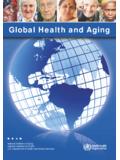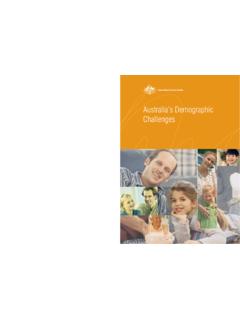Transcription of FALLS IN OLDER PEOPLE - WHO
1 1 FALLS IN OLDER PEOPLE NATIONAL / REGIONAL REVIEW INDIA Dr. B. Krishnaswamy, Professor and Head Dr. Gnanasambandam Usha, Assistant Professor Department of Geriatric Medicine Madras Medical College and Government General Hospital Chennai City, Tamil Nadu State, India 2 Table of Contents Page No. 1. Background / Introduction 3 2. Methods 3 3. Epidemiology of FALLS in OLDER population 4 4. Health services impact and costs of FALLS in OLDER PEOPLE 7 5. Interventions/best practice of FALLS prevention: 12 6. FALLS prevention policies & sustainability 15 7. Conclusions 15 8. Recommendations 16 9. References 18 3 Background / Introduction The number of persons above the age of 60 years is fast growing, especially in India.
2 India as the second most populous country in the world has million PEOPLE at or over the age of 60, constituting above of total population. The problems faced by this segment of the population are numerous owing to the social and cultural changes that are taking place within the Indian society. The major area of concern is the health of the elderly with multiple medical and psychological problems. FALLS are one of the major problems in the elderly and are considered one of the Geriatric Giants . Recurrent FALLS are an important cause of morbidity and mortality in the elderly and are a marker of poor physical and cognitive status. Evaluation of the morbidity profile among elderly PEOPLE , and the impact of chronic conditions on functional disability and psychological well-being are an essential part of comprehensive assessment of the elderly.
3 It will have implications for providing health care for the elderly population and its costs. There are few studies in Northern India which identify specific diseases that cause disability and consequent distress. Only three large-scale national surveys have been carried out exclusively with the aim of understanding the magnitude and pattern of various physical disabilities among the elderly population (Reddy and Sureender, 1992). Methods The review of studies relating to FALLS , FALLS prevention, unintentional injuries, fractures among elderly in India was made by internet searches, Medline search and hand searches of indexed journals. The research conducted by the Department of Geriatric Medicine, Government Hospital, Tamil Nadu is also included.
4 Efforts were taken to follow the cross references by the authors of various studies specific to India. 4 Only Indian studies were chosen to be incorporated in this report. Researches carried out with the aging population only are included. Results Epidemiology of FALLS in OLDER population Risk factors for FALLS include muscle weakness, a history of FALLS , use of four or more prescription medications, use of an assistive device, arthritis, depression, age OLDER than 80 years, and impairments in gait, balance, cognition, vision, and activities of daily living. Most FALLS result from a complex interplay of predisposing and precipitating factors in a person s environment.
5 One half to two thirds of FALLS occur in or around the patient s home. In a Multi-centric Community Study, evaluating Health Problems in the Elderly (Year 2003), in 10 states across India, covering a total population of 10,200 elderly with equal rural and urban distribution, the incidence of FALLS (History of a single fall in the last 6 months) was found to be 14% (Data to be published) Among the 35 states and union territories in India, Kerala has registered the highest proportion of elderly. The aged in Kerala constitute 11% of the population. Between 1961 and 1991, there has been 160% increase in the population of OLDER adults, the majority of them being women.
6 Their population, which was 9% in 1991, is expected to increase to 37% by 2051. The Kerala Aging Survey (KAS), conducted among more than 5,000 elderly (2,271 men and 2,722 women) in 14 districts of Kerala, was the keystone of the study. The results of the survey have shown that the age of participants ranged 5 from 60 to over 100 years of age with 54% being women. The results of the study show that FALLS and fractures are a significant issue among OLDER adults . Joshi, Rajesh Kumar and Avasthi (2003) conducted a cross-sectional survey of 200 subjects over 60 years old (100 each from the urban population of Chandigarh City and the rural population of Haryana State of India) was carried out using a cluster sampling technique.
7 The study period was July 1999 April 2000. Various socio-demographic characteristics were recorded at baseline. A clinical diagnosis was made by a physician based on reported illness, clinical examination, and cross-checking of medical records and medications held by the subjects. Psychological distress and disability was assessed using the PGI-Health Questionnaire-N-1 and the Rapid Disability Rating Scale-2, respectively. ANOVA, Kruskal Wallis H test, correlation coefficient, and multivariate analysis were used to assess the relationship and association of morbidity with other variables. Assessment of the morbidity profile and its determinants will help in the application of interventions, both medical and social, to improve the health status and thus the quality of life of the elderly in Northern India.
8 The distribution of history of fall among elderly PEOPLE over 60 years old shows that, out of the total sample population, 103 ( ) subjects had fallen. Fracture was reported in , and other injuries occurred in of those who had fallen. Fractures among females ( ) were reported more frequently compared with males (16%) and fracture was seen more in urban subjects ( ) compared with rural subjects ( ). History of fall and fall frequency was seen to be significantly associated with disability and psychological distress. Higher disability and consequent increasing distress was noted among those with a prior history of fall after 60 years of age and those with a history of three or more FALLS .
9 The significance of FALLS among elderly PEOPLE is that not only that the number of FALLS increases with age but the injury rate is highest among the oldest old (80 years) subjects with 6 history of falling more than twice. There is a vicious cycle where, due to poor perceived health and morbidity there is increased tendency to fall which itself leads to increasing disability and distress. Relationship of morbidity profile with disability and psychological distress Disability Psychological distress Morbidity N Mean (SD) P-value Mean (SD) P-value History of FALLS Yes 103 ( ) ( ) No 97 ( ) ( ) Frequency of falling 2 152 ( ) ( ) 3 + 48 ( ) ( ) Rashmi and Lalita (2005) in a presentation has pointed out that hip fractures in elderly PEOPLE are almost always the result of FALLS .
10 Regular exercise increases muscle strength, coordination and flexibility and reduces the tendency to fall . Exercise reduces the risk of falling by 10%, and balance training programs reduces the risk by nearly 20%. The elimination of environmental hazards, the avoidance of drugs which impair balance and management of neuromuscular disorders play a role in fracture prevention (Wark, 1993). Johnson (2006) examined the frequency and nature of FALLS and fall -related injuries among OLDER women in the state of Kerala, India. The study involved 82 community living and 63 institutionalized women aged 60 years or OLDER in Trivandrum, Kerala, India. Demographic data and FALLS profile were collected through the use of a field survey.














